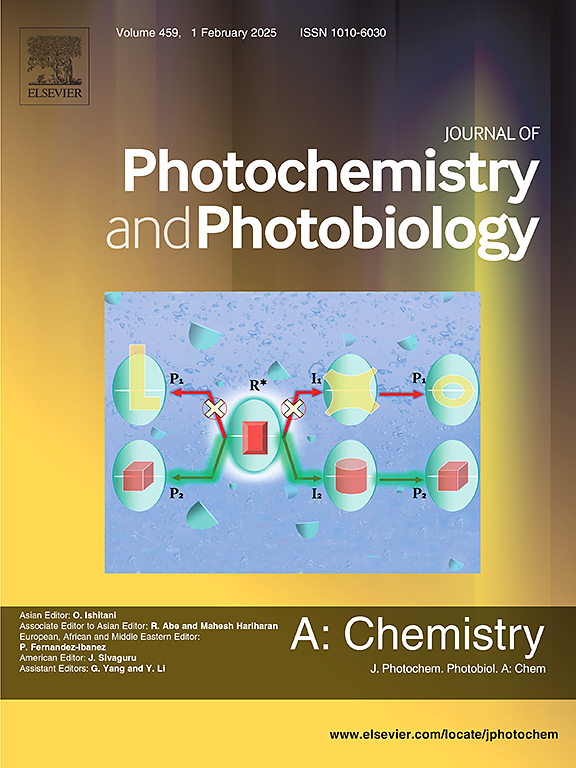Dual antioxidant-oxidant activity, optical properties and thermal stability of 1,5-diaminonaphthalene
IF 4.7
3区 化学
Q2 CHEMISTRY, PHYSICAL
Journal of Photochemistry and Photobiology A-chemistry
Pub Date : 2025-06-04
DOI:10.1016/j.jphotochem.2025.116541
引用次数: 0
Abstract
1,5-Diaminonaphthalene (DAN) is a small polyaromatic molecule known for its remarkable antioxidant properties. While its effective radical-scavenging activity under ambient conditions has been previously documented, this study unveils an equally compelling yet contrasting duality in the nature of this molecule. Indeed, DAN can also act as a photosensitizer under UV light irradiation, generating reactive singlet oxygen species, 1O2. We have studied the mechanisms underlying this dual behavior using a combination of characterization techniques, including FTIR, XRD, thermogravimetric analysis, UV–Vis spectroscopy, and electronic paramagnetic resonance. Without light, DAN efficiently neutralizes the 2,2-Diphenyl-1-picrylhydrazyl (DPPH·) radicals used as probe molecules through hydrogen atom transfer and exhibits antioxidant properties. However, under UV-light irradiation, DAN nature shifts dramatically. The photo-stimulation enables the production of reactive singlet oxygen with significant oxidative response, as demonstrated by the test with the standard probe indocyanine green. This light-triggered transformation highlights the versatility of DAN, bridging its use as a radical scavenger and pro-oxidant. The findings pave the way for exploiting the dynamic redox properties of DAN in designing multifunctional nanomaterials where controlled oxidative and antioxidative responses are critical.

1,5-二氨基萘的双抗氧化活性、光学性质和热稳定性
1,5-二氨基萘(DAN)是一种小的多芳香分子,以其卓越的抗氧化性能而闻名。虽然其在环境条件下有效的自由基清除活性先前已被记录,但本研究揭示了该分子性质中同样引人注目但对比鲜明的二元性。事实上,DAN在紫外光照射下也可以作为光敏剂,产生活性单线态氧1O2。我们利用FTIR、XRD、热重分析、UV-Vis光谱和电子顺磁共振等表征技术研究了这种双重行为背后的机制。在没有光照的情况下,DAN通过氢原子转移有效中和作为探针分子的2,2-二苯基-1-吡啶肼基(DPPH·)自由基,并表现出抗氧化性能。然而,在紫外线照射下,DAN的性质发生了巨大的变化。光刺激能够产生具有显著氧化反应的活性单重态氧,正如用吲哚菁绿标准探针进行的测试所证明的那样。这种光触发的转变突出了DAN的多功能性,架起了它作为自由基清除剂和促氧化剂的桥梁。这些发现为利用DAN的动态氧化还原特性设计多功能纳米材料铺平了道路,在这些纳米材料中,控制氧化和抗氧化反应是至关重要的。
本文章由计算机程序翻译,如有差异,请以英文原文为准。
求助全文
约1分钟内获得全文
求助全文
来源期刊
CiteScore
7.90
自引率
7.00%
发文量
580
审稿时长
48 days
期刊介绍:
JPPA publishes the results of fundamental studies on all aspects of chemical phenomena induced by interactions between light and molecules/matter of all kinds.
All systems capable of being described at the molecular or integrated multimolecular level are appropriate for the journal. This includes all molecular chemical species as well as biomolecular, supramolecular, polymer and other macromolecular systems, as well as solid state photochemistry. In addition, the journal publishes studies of semiconductor and other photoactive organic and inorganic materials, photocatalysis (organic, inorganic, supramolecular and superconductor).
The scope includes condensed and gas phase photochemistry, as well as synchrotron radiation chemistry. A broad range of processes and techniques in photochemistry are covered such as light induced energy, electron and proton transfer; nonlinear photochemical behavior; mechanistic investigation of photochemical reactions and identification of the products of photochemical reactions; quantum yield determinations and measurements of rate constants for primary and secondary photochemical processes; steady-state and time-resolved emission, ultrafast spectroscopic methods, single molecule spectroscopy, time resolved X-ray diffraction, luminescence microscopy, and scattering spectroscopy applied to photochemistry. Papers in emerging and applied areas such as luminescent sensors, electroluminescence, solar energy conversion, atmospheric photochemistry, environmental remediation, and related photocatalytic chemistry are also welcome.

 求助内容:
求助内容: 应助结果提醒方式:
应助结果提醒方式:


